Study on the Fire Damage Characteristics of the New Qidaoliang Highway Tunnel: Field Investigation with Computational Fluid Dynamics (CFD) Back Analysis
Abstract
:1. Introduction
2. General Situation of the Tunnel and Fire
3. Analysis of Characteristics of Tunnel after Fire
3.1. Tunnel Dregs Condition
3.2. Evaluation of Strength of Tunnel Lining
3.2.1. Evaluation of the Vault Strength of Lining
3.2.2. Evaluation of the Side Wall Strength
3.3. Damage Condition of Road Surface and Waterproof Board
3.4. Loss of Cross-Section Area
3.5. Affiliated Facilities Damage Condition
3.6. Structural Damage Rating
- Seriously damaged section: K18+657.5~K18+776, 118.5 m in total. A large area of the second layer lining concrete was spalled, exposing rebars in the second lining. The hole lining structure was completely damaged; the steel arch in the second lining at the draught fan was exposed, with the spalling depth of 10–35 cm. There was heavy damage to the concrete strength of the hole top, and the traffic safety facilities, mechanical and electrical facilities were all damaged. Based on the observation, the damage rating is given as grade IV.
- Moderately damaged section: K18+620~K18+657.5 and K18+776~K18+923, 184.5 m in total. The large area of the second lining concrete of this section was spalled, with spalling depth of 2–7 cm, and some parts over 10 cm. There was serious damage to the part below the hole lining and lamps, and great loss of concrete strength of the hole top. Part of the road surface, traffic safety facilities, and mechanical and electrical facilities were all damaged. Based on the observation, the damage rating is given as grade III.
- Section with minor damage: K18+530~620 and K18+923~K19+090, 257 m in total. Some areas of the second lining of concrete of this section was spalled, with spalling depth of 2–6 cm. There was less loss of concrete strength at the hole top, with the surface in good condition. The traffic safety facilities, and mechanical and electrical facilities were all damaged. Based on the observation, the damage rating is given as grade II.
4. Numerical Simulation of the Fire Scenario
4.1. Numerical Model
4.1.1. Software used and Basic Assumptions
4.1.2. Tunnel Model and Boundary Conditions
Tunnel Model
Boundary Conditions
4.1.3. Heat Release Confirmation and Combustion Model Selection
Heat Release Confirmation
Combustion Model Selection
4.1.4. Calculation Model Selection
4.1.5. Input Parameters in the Simulation
4.2. Calculation Result Analysis
4.2.1. Longitudinal Temperature Field Contribution Rule in the Tunnel
4.2.2. Lateral Temperature Field in the Tunnel
4.2.3. Longitudinal Temperature Field in the Tunnel Lining
4.2.4. Lateral Temperature Field in the Tunnel Lining
5. Conclusions
- The fire results in an exfoliation covering an area of 856 m3, weakening the solidity of the remaining lining masonry and damaging the road to a length of 650 m. The maximum area loss happened at the spot of the fire with maximum observed concrete spallation up to a thickness of 35.4 cm. The strength of vault and side wall concrete near the fire source was significantly reduced. The loss of concrete strength of side wall near inner surface of tunnel was larger than that near the surrounding rock.
- Numerical simulation indicates that the tunnel went through the process of a small range of area heating up, with an eddy, backflow and lengthway flow happening around the fire during the outbreak of the fire until fire stability. The temperature inside the tunnel changed in accordance with the distance away from the fire, the farther the lower. The downstream of the tunnel was more influential than the upstream. At the same distance away from the fire, the downstream section had a higher temperature than the upstream. Horizontally, the heat mainly gathered in vault or in the higher part—the arch waist for both the upstream and downstream of the fire. The temperature near fire within the tunnel did not show clear stratification.
- The influence of the fire in the upstream is greater than in the downstream. From the perspective of vertical temperature, the length of the damage in all grades is in accordance with the results tested on the spot. The horizontal temperatures within tunnel lining of both downstream and upstream distant from the fire showed a phenomenon of stratification. The highest temperature lies in the vault. There was no clear gradient of temperatures among the vault, the arch waist, and the side wall of transverse section which was near the source of ignition and the downstream part nearby. As for the size of measurement, the thickness where the temperature within tunnel lining near the fire seat was above 800 °C coincides with the depth of exfoliation on field test.
Acknowledgements
Author Contributions
Conflicts of Interest
References
- Roh, J.S.; Yang, S.S.; Hong, S.R. Tunnel fires: Experiments on critical velocity and burning rate in pool fire during longitudinal ventilation. J. Fire Sci. 2007, 25, 161–176. [Google Scholar] [CrossRef]
- Leitner, A. The fire catastrophe in the tauern tunnel: Experience and conclusions for the austrian guidelines. Tunn. Undergr. Space Technol. 2001, 16, 217–223. [Google Scholar] [CrossRef]
- Oka, Y.; Atkinson, G.T. Control of smoke flow in tunnel fires. Fire Saf. J. 1995, 25, 305–322. [Google Scholar] [CrossRef]
- Ingason, H.; Lönnermark, A. Heat release rates from heavy goods vehicle trailer fires in tunnels. Fire Saf. J. 2005, 40, 646–668. [Google Scholar] [CrossRef]
- Kim, D.H.; Park, W.H. Experiment by using reduced scale models for the fire safety of a rescue station in very long rail tunnel in Korea. Tunn. Undergr. Space Technol. 2006. [Google Scholar] [CrossRef]
- Zhao, H.L.; Xu, Z.S.; Jiang, X.P. Reduced-scale model tests of fires in railway tunnel and structure fire safety. Adv. Mater. Res. 2010, 168, 2473–2476. [Google Scholar] [CrossRef]
- Minehiro, T.; Fujita, K.; Kawabata, N.; Hasegawa, M.; Tanaka, F. Backlayering distance of thermal fumes in tunnel fire experiments using a large-scale model. J. Fluid Sci. Technol. 2012, 7, 389–404. [Google Scholar] [CrossRef]
- Wu, Y.; Bakar, M.Z.A. Control of smoke flow in tunnel fires using longitudinal ventilation systems—A study of the critical velocity. Fire Saf. J. 2000, 35, 363–390. [Google Scholar] [CrossRef]
- Li, J.S.M.; Chow, W.K. Numerical studies on performance evaluation of tunnel ventilation safety systems. Tunn. Undergr. Space Technol. 2003, 18, 435–452. [Google Scholar] [CrossRef]
- Hwang, C.C.; Edwards, J.C. The critical ventilation velocity in tunnel fires—A computer simulation. Fire Saf. J. 2005, 40, 213–244. [Google Scholar] [CrossRef]
- Hu, L.H.; Huo, R.; Peng, W.; Chow, W.K.; Yang, R.X. On the maximum smoke temperature under the ceiling in tunnel fires. Tunn. Undergr. Space Technol. 2006, 21, 650–655. [Google Scholar] [CrossRef]
- Kim, E.; Woycheese, J.P.; Dembsey, N.A. Fire dynamics simulator (version 4.0) simulation for tunnel fire scenarios with forced, transient, longitudinal ventilation flows. Fire Technol. 2008, 44, 137–166. [Google Scholar] [CrossRef]
- Roh, J.S.; Hong, S.R.; Park, W.H.; Yong, J.J. CFD simulation and assessment of life safety in a subway train fire. Tunn. Undergr. Space Technol. 2009, 24, 447–453. [Google Scholar] [CrossRef]
- Tilley, N.; Rauwoens, P.; Merci, B. Verification of the accuracy of CFD simulations in small-scale tunnel and atrium fire configurations. Fire Saf. J. 2011, 46, 186–193. [Google Scholar] [CrossRef]
- Guo, X.; Zhang, Q. Analytical solution, experimental data and CFD simulation for longitudinal tunnel fire ventilation. Tunn. Undergr. Space Technol. 2014, 42, 307–313. [Google Scholar] [CrossRef]
- Teodosiu, C.I.; Ilie, V.; Dumitru, R.G.; Teodosiu, R.S. Assessment of ventilation efficiency for emergency situations in subway systems by CFD modeling. Build. Simul. 2016, 9, 319–334. [Google Scholar] [CrossRef]
- Faure, R.M.; Karray, M. Investigation of the concrete lining after the mont blanc tunnel fire. Struct. Eng. Int. 2007, 17, 123–132. [Google Scholar] [CrossRef]
- Lai, H.P.; Wang, S.Y.; Xie, Y.L. Experimental research on temperature field and structure performance under different lining water contents in road tunnel fire. Tunn. Undergr. Space Technol. 2014, 43, 327–335. [Google Scholar] [CrossRef]
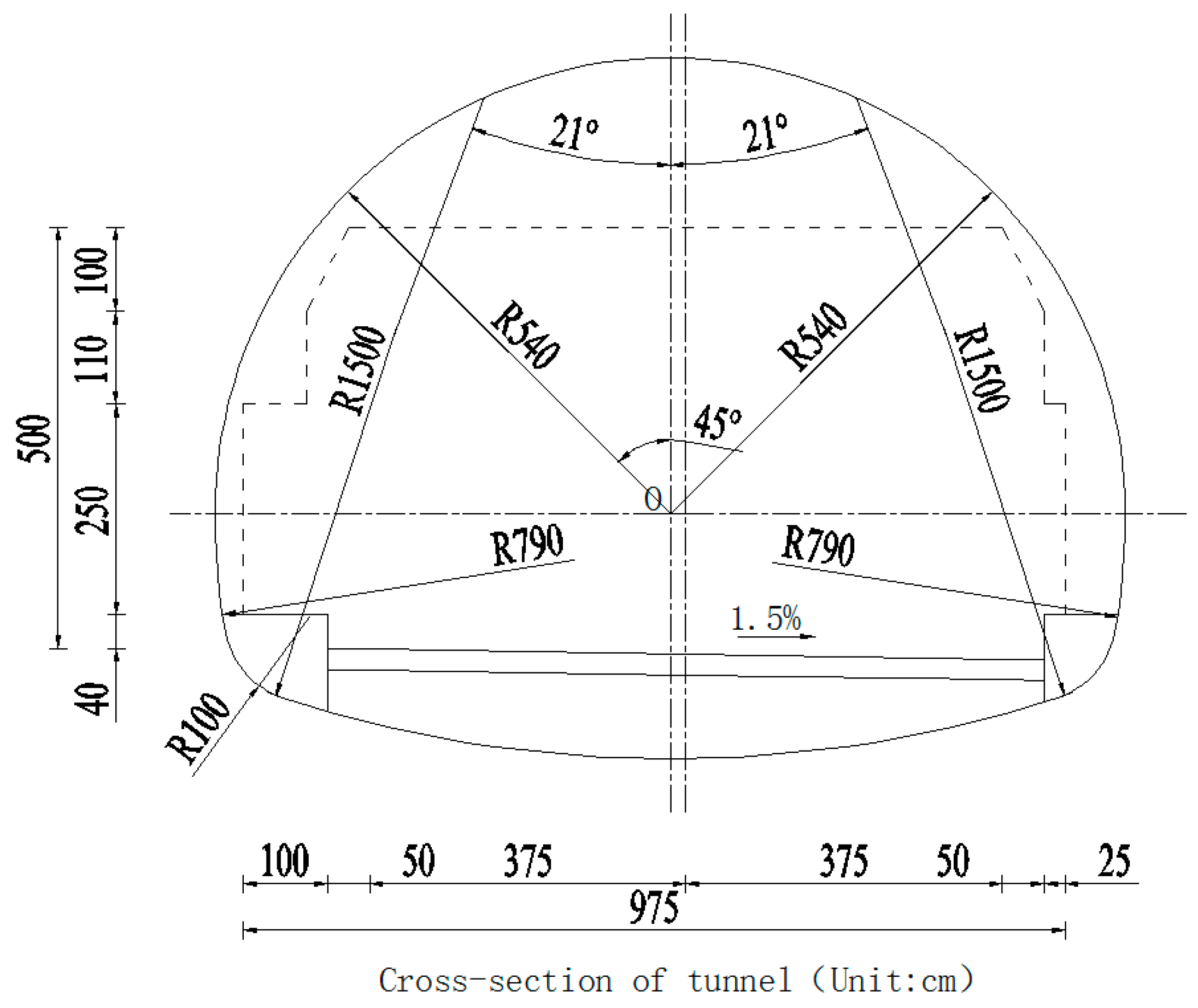
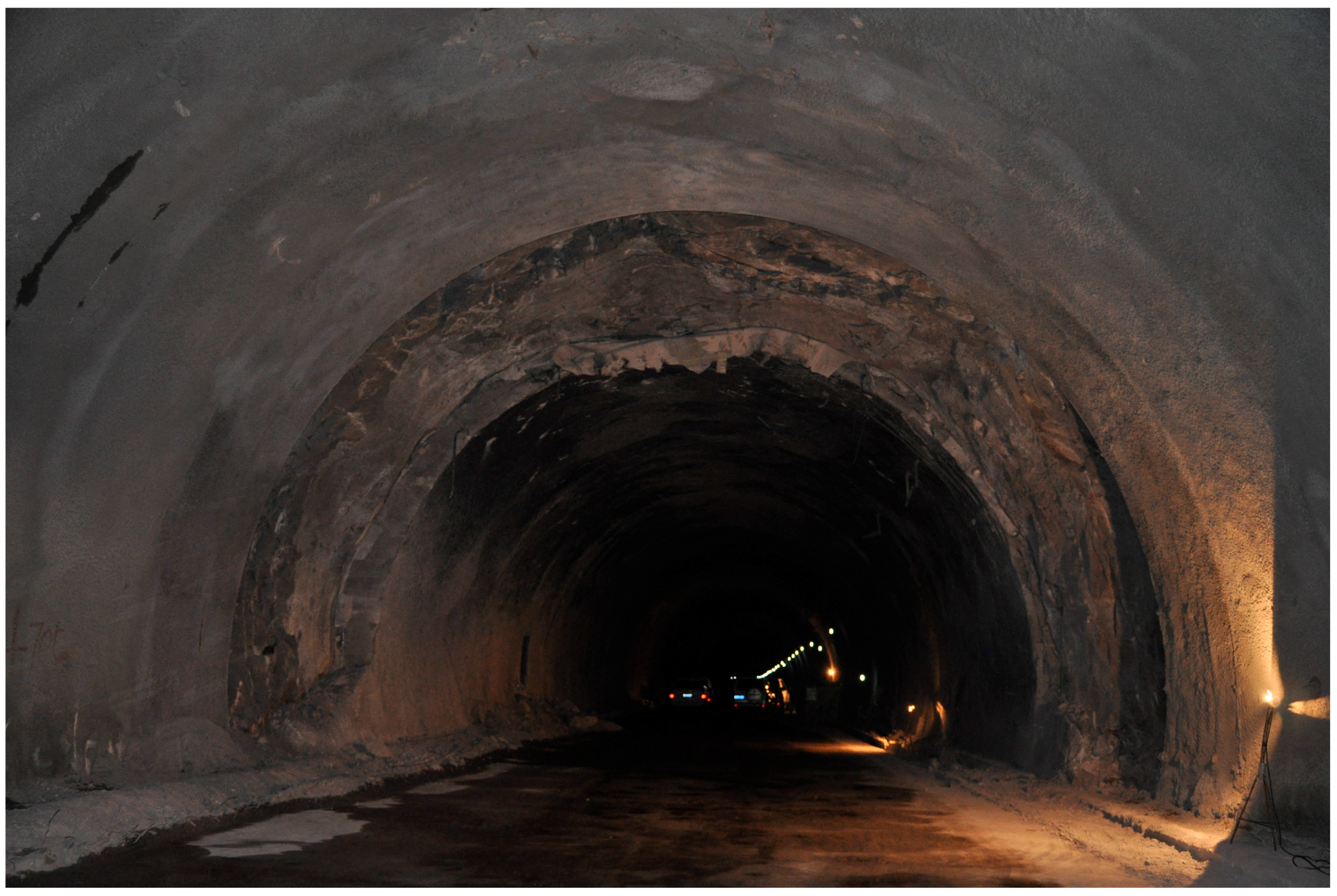
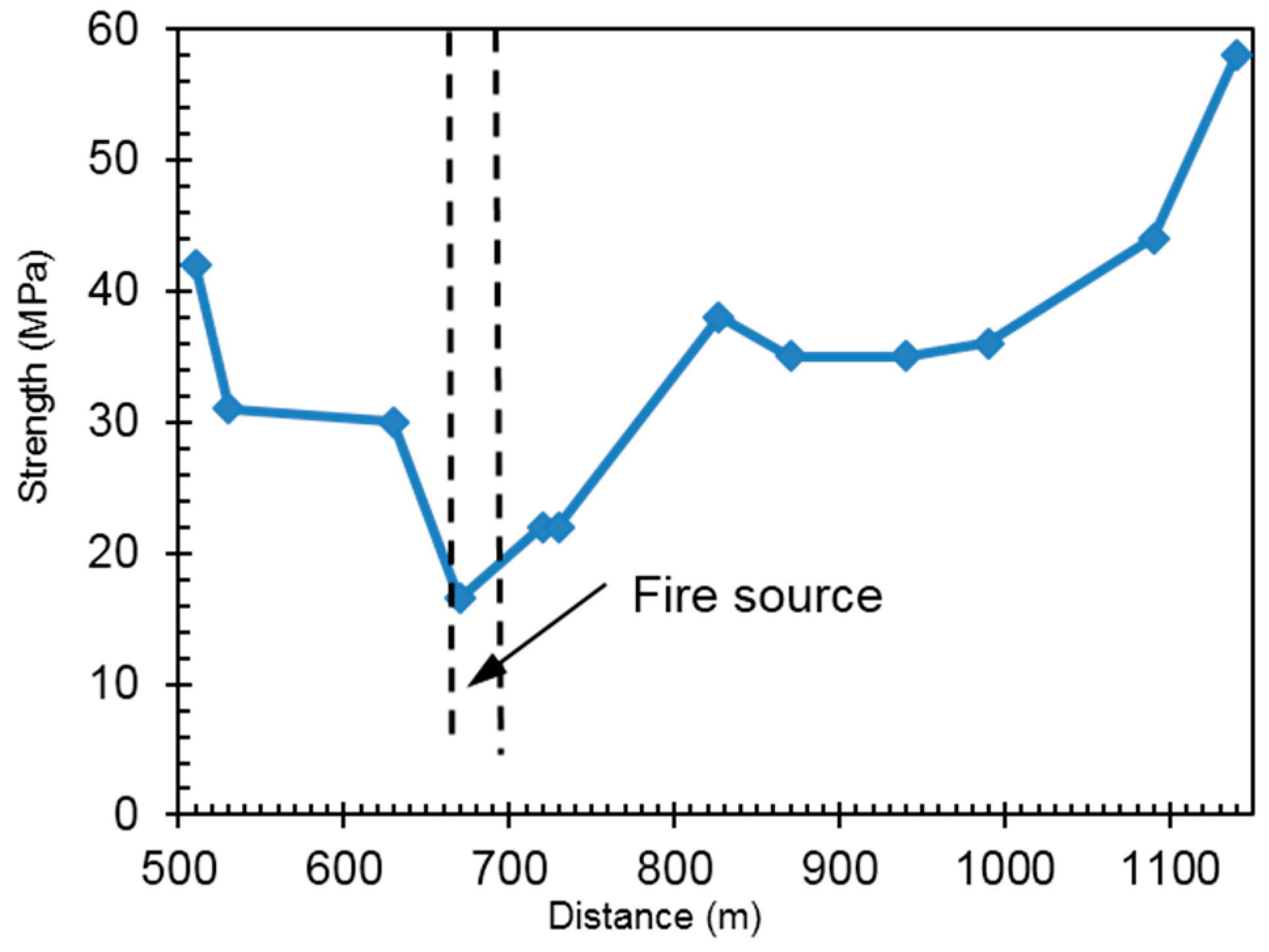

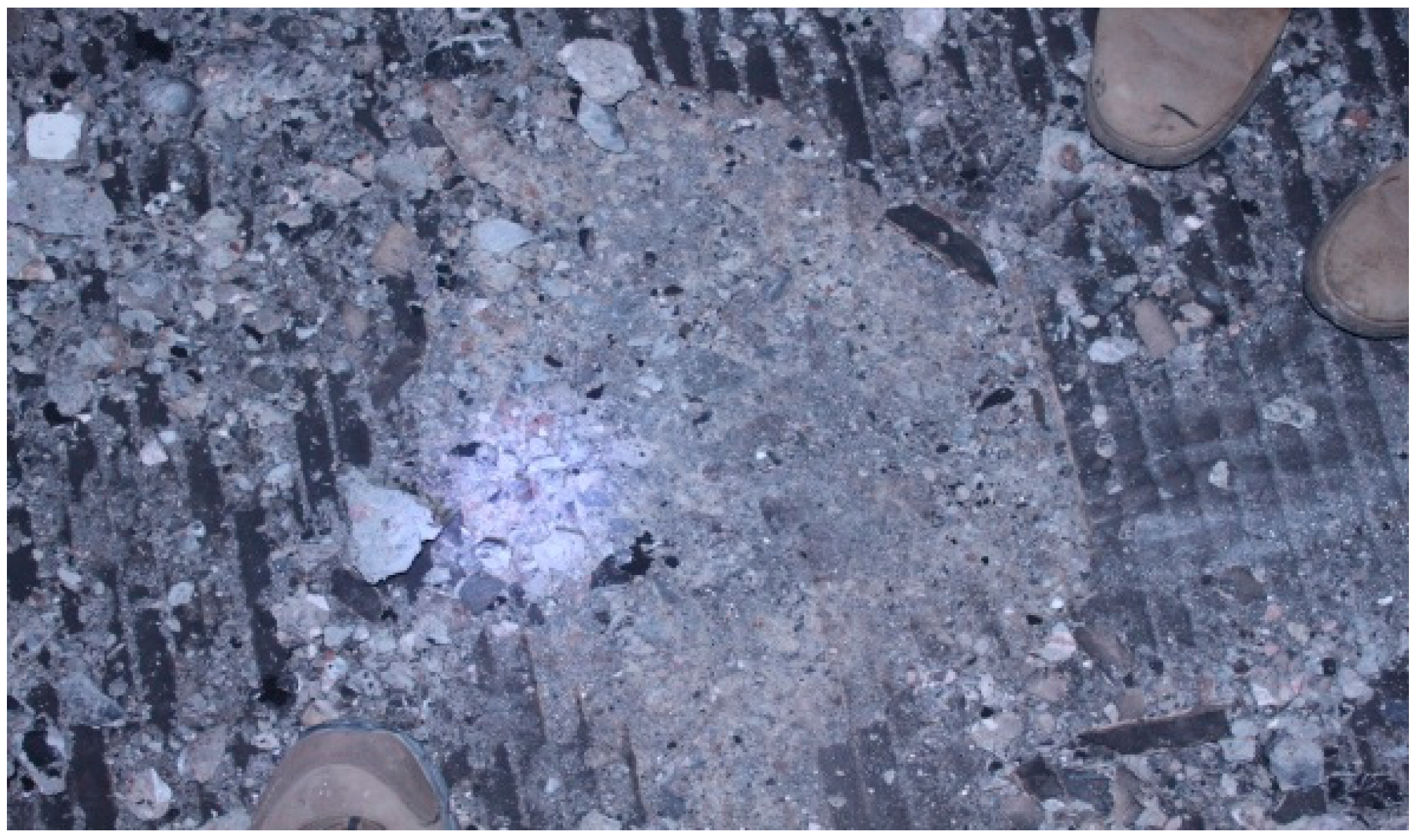
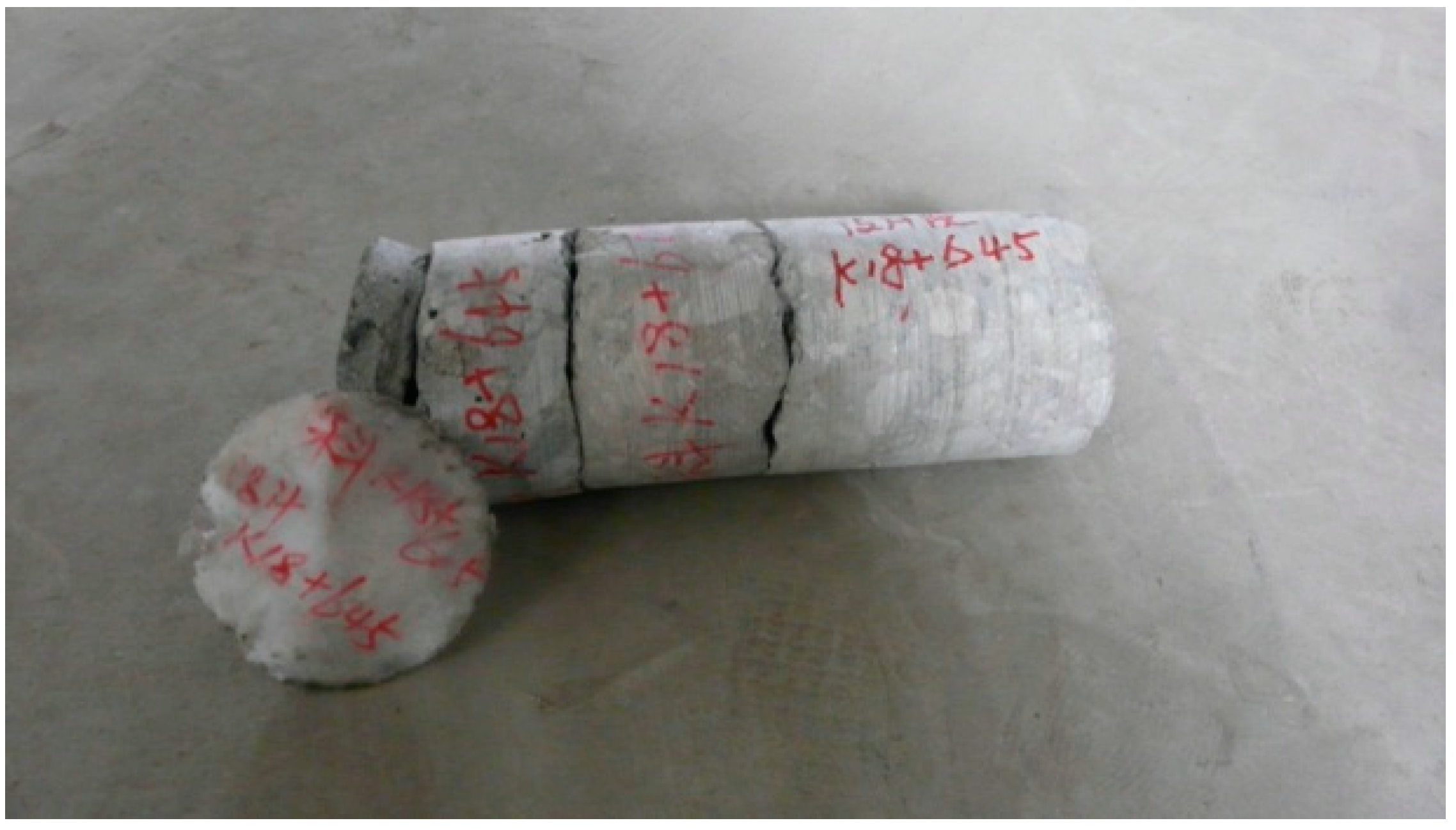

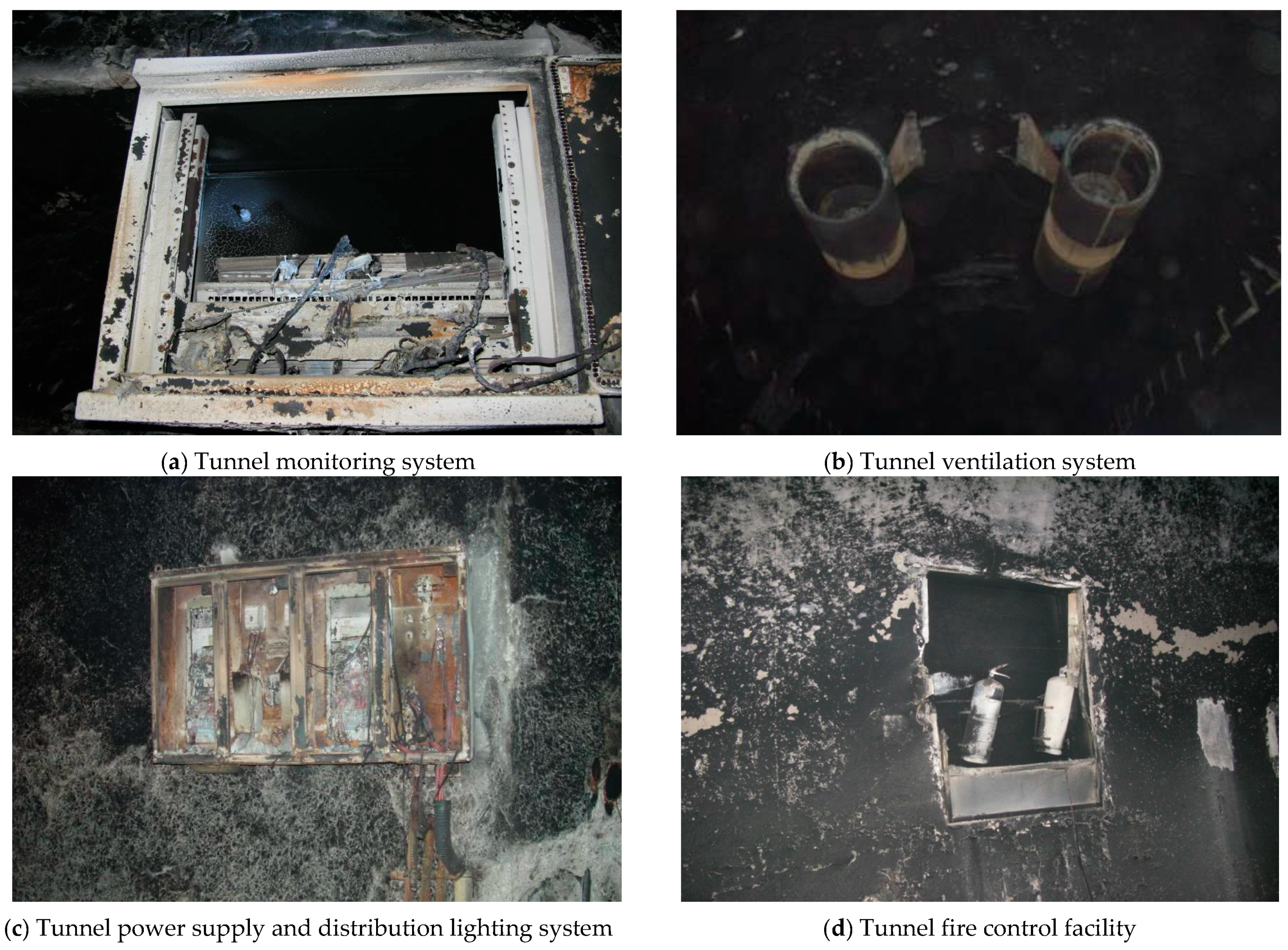
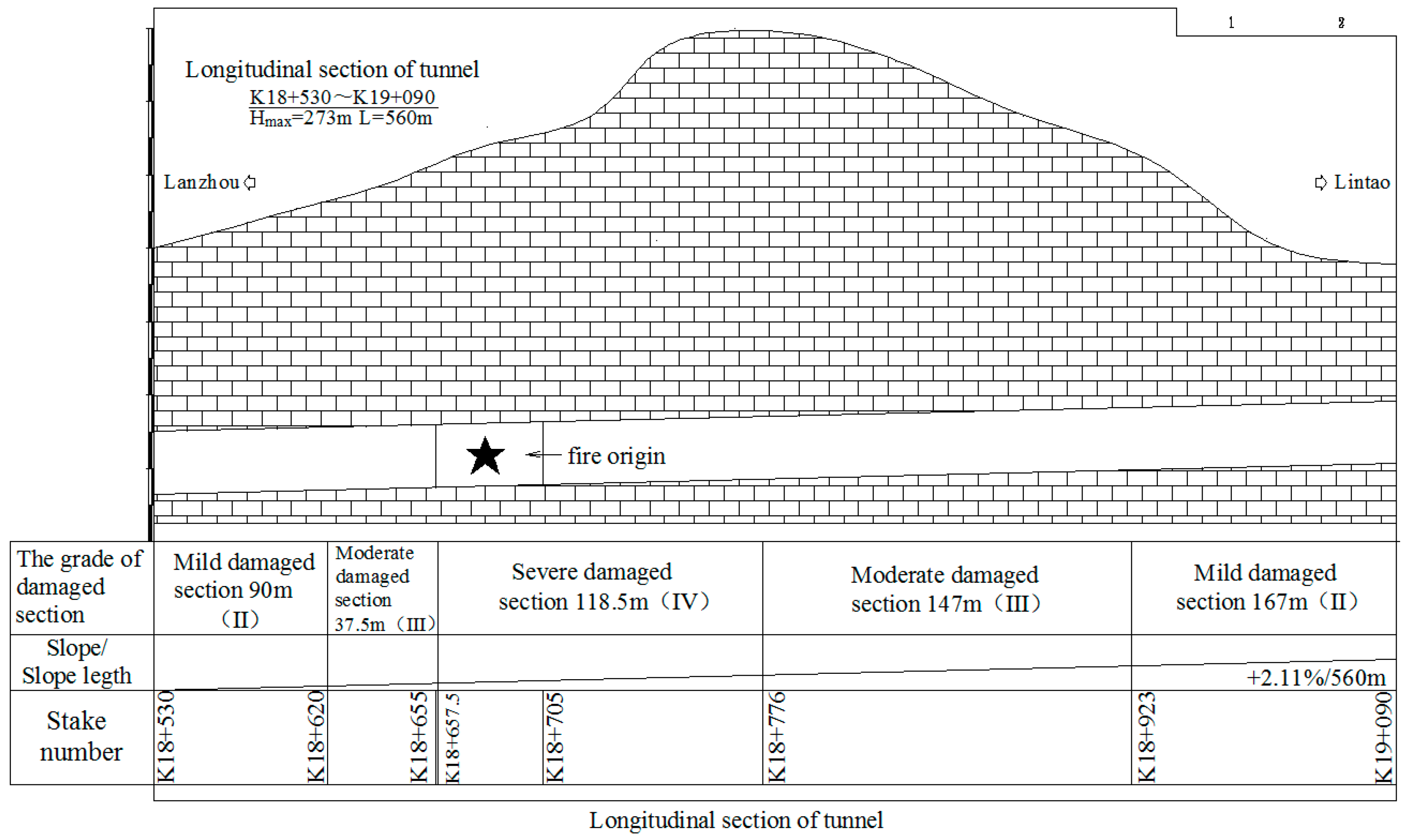

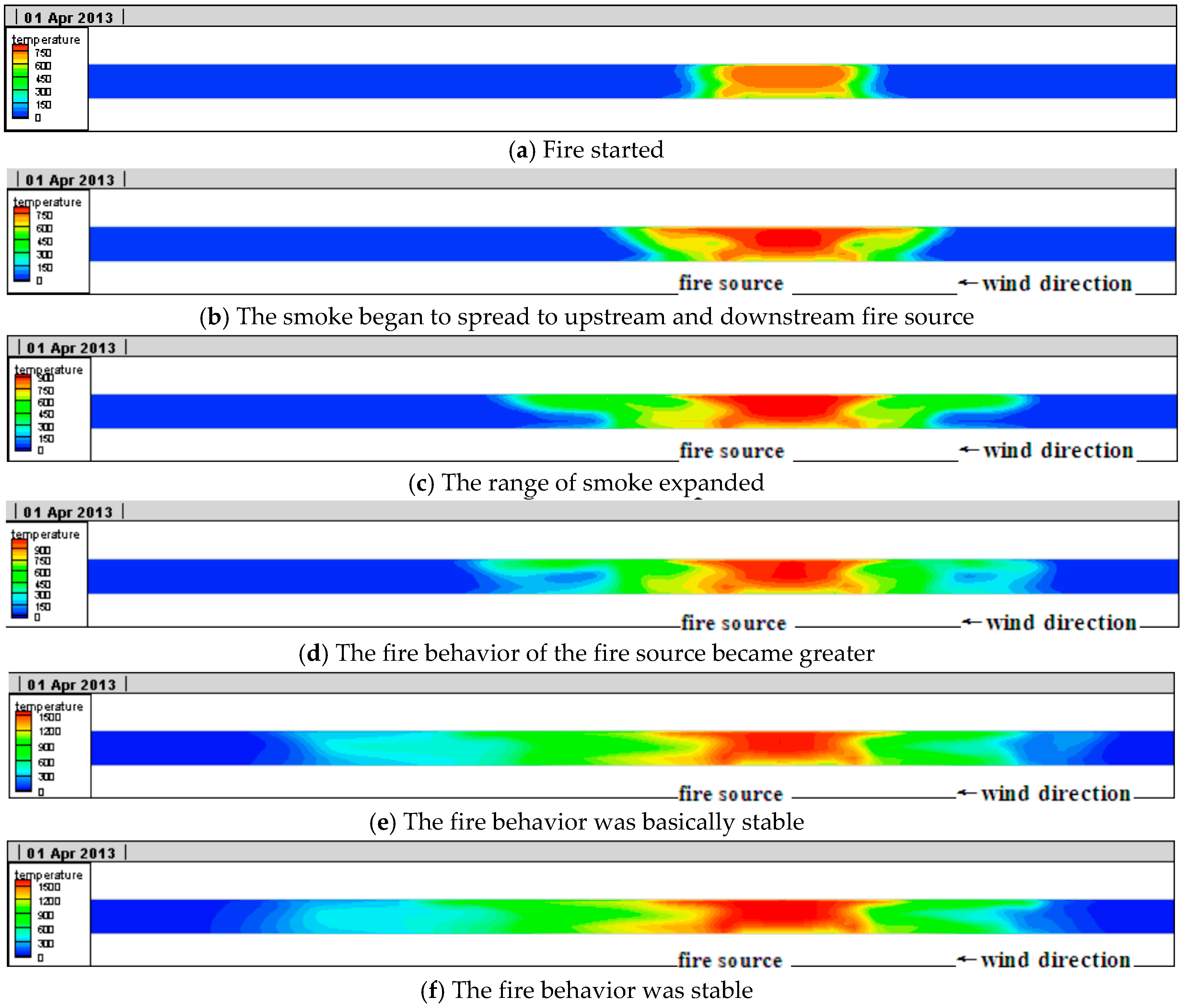
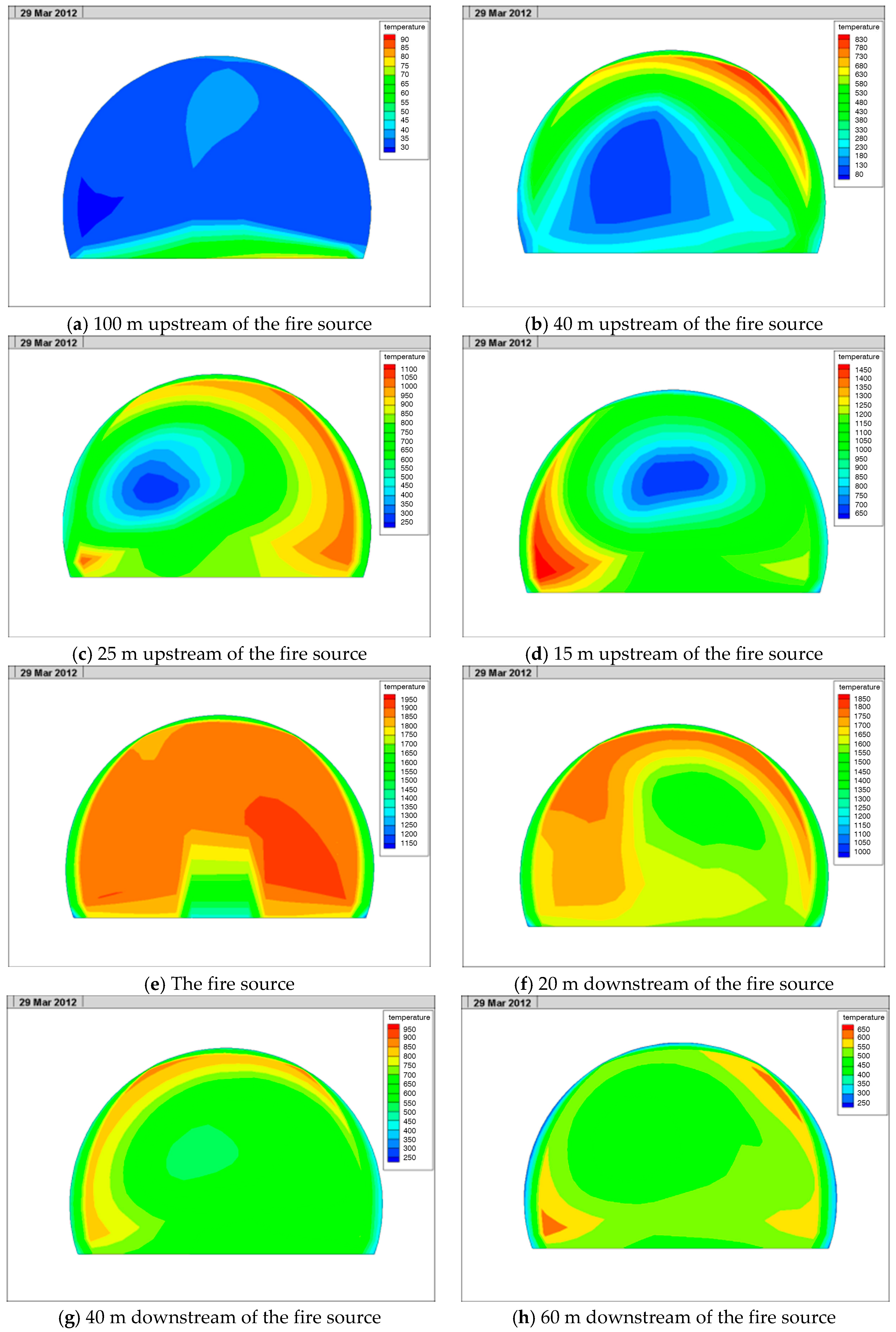
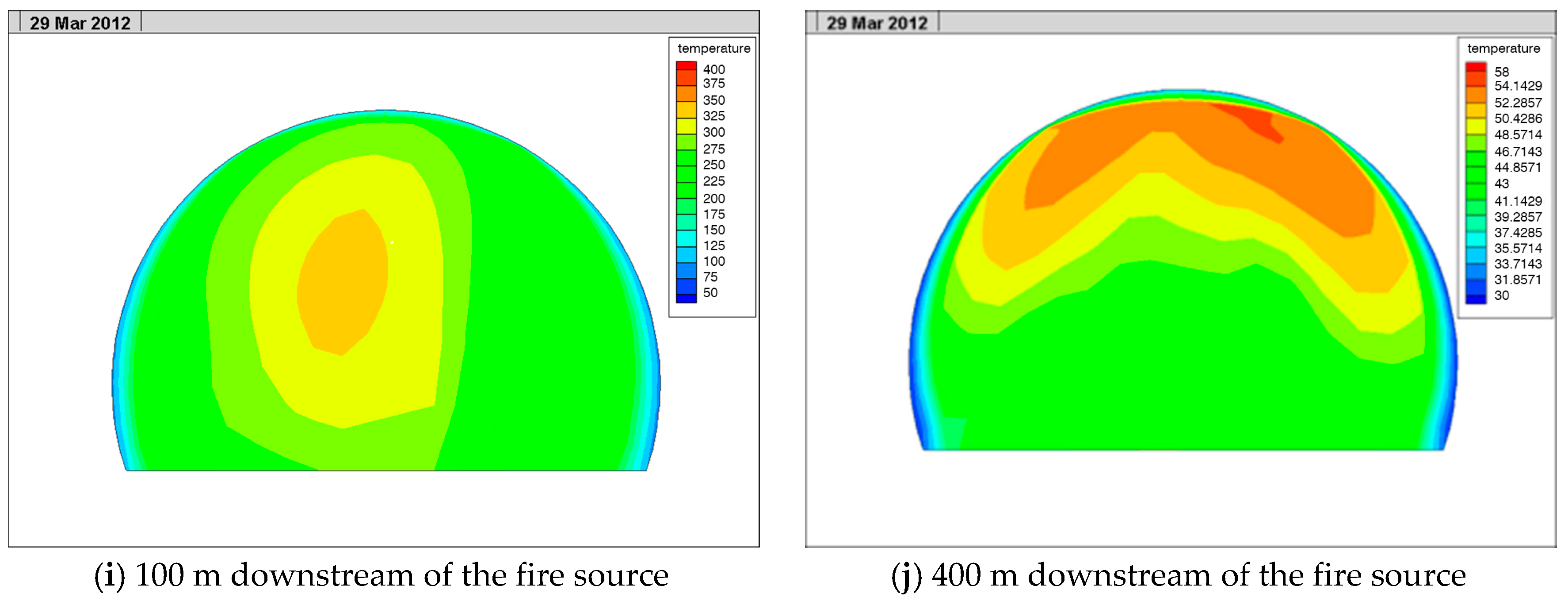
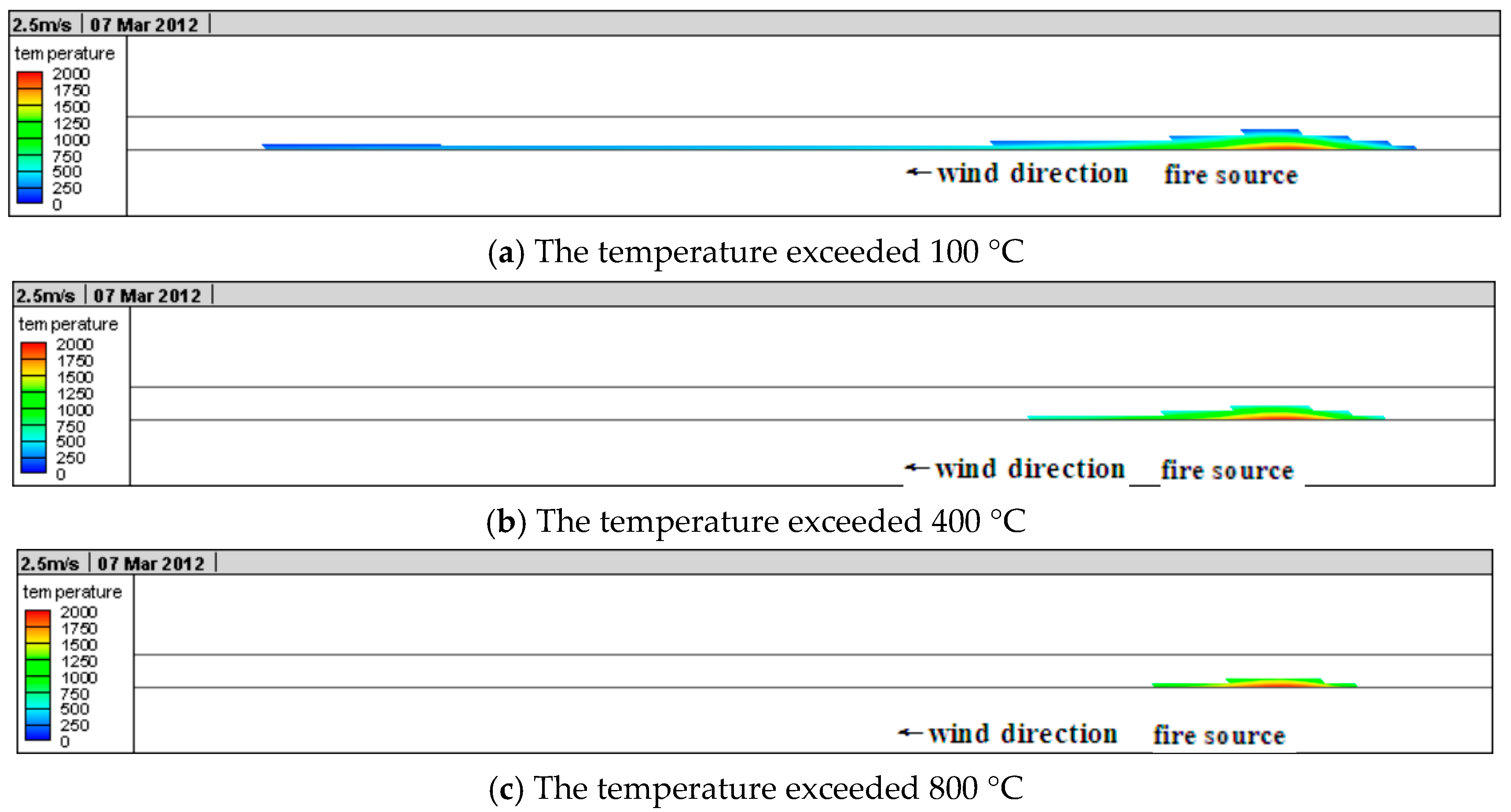

© 2016 by the authors; licensee MDPI, Basel, Switzerland. This article is an open access article distributed under the terms and conditions of the Creative Commons Attribution (CC-BY) license (http://creativecommons.org/licenses/by/4.0/).
Share and Cite
Lai, H.; Wang, S.; Xie, Y. Study on the Fire Damage Characteristics of the New Qidaoliang Highway Tunnel: Field Investigation with Computational Fluid Dynamics (CFD) Back Analysis. Int. J. Environ. Res. Public Health 2016, 13, 1014. https://doi.org/10.3390/ijerph13101014
Lai H, Wang S, Xie Y. Study on the Fire Damage Characteristics of the New Qidaoliang Highway Tunnel: Field Investigation with Computational Fluid Dynamics (CFD) Back Analysis. International Journal of Environmental Research and Public Health. 2016; 13(10):1014. https://doi.org/10.3390/ijerph13101014
Chicago/Turabian StyleLai, Hongpeng, Shuyong Wang, and Yongli Xie. 2016. "Study on the Fire Damage Characteristics of the New Qidaoliang Highway Tunnel: Field Investigation with Computational Fluid Dynamics (CFD) Back Analysis" International Journal of Environmental Research and Public Health 13, no. 10: 1014. https://doi.org/10.3390/ijerph13101014




